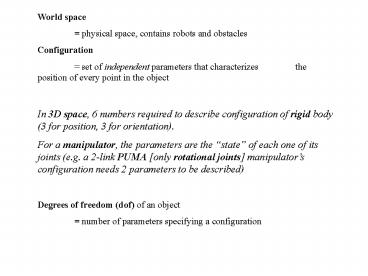Motion Planning PowerPoint PPT Presentation
1 / 13
Title: Motion Planning
1
World space physical space, contains robots
and obstacles Configuration set of independent
parameters that characterizes the position of
every point in the object In 3D space, 6 numbers
required to describe configuration of rigid body
(3 for position, 3 for orientation). For a
manipulator, the parameters are the state of
each one of its joints (e.g. a 2-link PUMA only
rotational joints manipulators configuration
needs 2 parameters to be described) Degrees of
freedom (dof) of an object number of
parameters specifying a configuration
2
gt6-dof manipulators in 3D space belong to the
class of redundant manipulators, more flexible,
free to use extra dof as wish to solve MP (Motion
Planning) problem
3
Configuration space (Cspace) set of all
configurations Free space (Cfree) set of
allowed (feasible) configurations Obstacle space
(Cobstacle) set of disallowed configurations
Cspace Cfree Cobstacle
4
- Path of an object
- curve in the configuration space
- represented either by
- Mathematical expression, or
- Sequence of points
- Trajectory
- Path assignment of time to points along the
path - Motion Planning (MP), a general term, either
- Path planning, or
- Trajectory planning
5
- Path planning
- design of only geometric (kinematic)
specifications of the positions and orientations
of robots - Trajectory planning
- path planning design of linear and angular
velocities - Path planning lt Trajectory planning
- at path planning, dynamics of robots unimportant
or neglected - path planning also used as first step in design
of trajectories
6
- Static motion planning
- obstacle info known a priori
- motion of robot designed from given information
- Dynamic motion planning
- partial obstacle info available (e.g. visible
parts) - Initial planning based on the available
information - Follows planned path, discovering more obstacle
info - Updates internal representation of environment
- Replans path
- Continued till goal accomplished
- Most papers in MP, up to 1992, deal with static
case
7
- Generalized movers problem
- given
- Robot with d degrees of freedom (dof)
- In an environment with n obstacles
- Find path
- collision-free
- connecting current (start) configuration to
desired (goal) one
8
- Completeness (classification of MP algorithms)
- Exact
- usually computationally expensive
- may determine bounds of a problems complexity
- Heuristic
- ained at genertating a solution in a short time
- may fail to find solution or find poor one at
difficult problems - important in engineering applications
- Resolution complete (discretization)
- Probabilistically complete (probabilistic
completeness ?1)
9
- Scope (classification of MP algorithms)
- Global
- take into account all environment information
- plan a motion from start to goal configuration
- Local
- avoid obstacles in the vincinity of the robot
- use information about nearby obstacles only
- used when start and goal are close together
- used as component in global planner, or
- used as safety feature to avoid unexpected
obstacles not present in environment model, but
sensed during motion
10
- MP formulation
- Configuration space (Cspace space of all
possible motions) - Object representation (robot and objects config.
obstacles) - Select motion planning approach (suitable to
problem) - Skeleton, Cell decomposition, Potential field,
Mathematical programming / optimization - Use search method(s), to find a solution path
- Local optimization of motion (get shorter and
smoother path) - smoother no sharp corners not have to use
very low speed
11
- Search methods
- Depth-first (not the shortest)
- Breadth-first / brushfire (shortest path,
examines large part) - Hill climbing / Best-first / Hypothesize and test
(blind-alley trap, long time) - A (minimum cost / shortest path, pruning)
- Bi-directional (combine with any algorithm,
narrow channels) - Dijkstras shortest-path for graphs (most
efficient) - Random search / simulated annealing (random,
long time) - MP -gt find connected sequence of feasible
configurations between start and goal ones
12
Best explained using a grid S Start
configuration G Goal configuration Dark
Infeasible configurations Parent configuration
-gt child configuration Each child has at max one
parent (avoid cycles/loops)
13
- Selection of search method
- If criterion for selecting good moving direction,
use best-first rather than depth-first or
breadth-first - If easy problem (free space wide, many motion
solutions, any solution adequate, not optimal
one), use depth-first or best-first - If shortest path desired, use A or Dijkstras
algorithm - Massively parallel computation ? breadth-first
effective - Bidirectional search whenever possible. Move from
cluttered to open space, harder to achieve a
configuration in cluttered space - If many MP with different start/goal, compute
spatial representation ahead - If one MP problem, do partial representation,
refine iteratively (ICORS) - Environment slow change, updating scheme, no
recomputation

